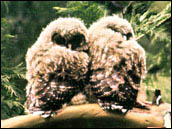| Yet, even with a map outlining the likely habitat of the owls,
scientists will still not be able to tell if the owls are surviving or
not. One last step is required. "We have to combine the
remote-sensing data with the demographic owl data," said Bill
Ripple, a member of the of the owl-habitat modeling team at Oregon State
University. In basic terms, the information collected about the owls on
the ground has to be matched up with the satellite maps.
Ripple said knowing the sheer amount of owl habitat is not enough to
determine whether the owls will survive. Other factors such as the
fragmentation of the old forest, the geometry of the owl habitat, and
the type of old forest all contribute to the owl's ability to survive
and reproduce.
|
|
|
| The trick is in discerning just how these features affect owl health
and reproductive success. "We will first bring together years of field
data collected by field crews monitoring owl offspring," said Ripple.
He and his team will comb through years of ground-based studies to see
what features of the landscape in an owl's hunting range cause the owls
to increase or decrease in number.
Once these patterns have been found, the Oregon State University team
will try to integrate them with the owl-habitat map. For instance, if
large fragmentation of the owl’s habitat causes a decline in the
population, then the researchers can rule out the areas on the map that
are highly fragmented. "We have just begun this five-year study," said
Ripple. "For all we know we may be unsuccessful." If they are
successful, only minimal ground surveys will be needed to see whether
the model continues to work. Cost will drop and the area could be
surveyed quickly.
Of course, this entire plan may be thwarted by natural selection
before these models can be completed. The barred owl, a close relative
of the spotted owl, has invaded the Pacific Northwest, said Forsman.
This owl can out hunt the spotted owl and is generally more resilient.
Worse than that, the barred owls can breed with the spotted owls.
Together they create a hybrid owl that can reproduce. "With the barred
owls out there, the data are getting really hard to interpret. The
associations [between the many variables] are becoming really
muddled," said Forsman. "In the end the spotted owl may get
kicked out of the forest anyway."
References
- U.S. Fish and Wildlife Service, 1996: An Environmental
Alternatives Analysis for the 4(d) Rule for the Northern Spotted Owl,
Portland, Oregon, 2-3.
- Bureau of Land Management, 1993: Standards and Guidelines for
Management of Habitat for Late-Successional and Old Growth Forest
Related Species Within the Range of the Spotted Owl, Portland, Oregon,
A1-A7.
- Lint, J., B. Noon, R. Anthony, E. Forsman, M. Raphael, M. Collopy,
and E. Starkey, 1999: Northern Spotted Owl Effectiveness Monitoring Plan
for the Northwest Forest Plan, United States Department of Agriculture,
Portland Oregon, 27-29.
- Townshend, J. R. G., C. J. Tucker, and S. N. Goward, 1993:
Global Vegetation Mapping. In R. J. Gurney, J. L. Foster, and C. L. Parkinson, (Eds.),Atlas of Satellite Observations Related to
Global Change, Cambridge University Press, London, 301-310.
- Earth From Above: Using Color Coded Satellite Images to Examine
the Global Environment, C. L. Parkinson, 1997: University Science
Books, Sausalito, California, 95-118.

 Searching for Spotted Owls from Outer Space Searching for Spotted Owls from Outer Space
| 
Although the population of northern spotted owls
has stabilized for now, long-term threats remain, not all of them due to human activity. (Photograph courtesy Jerry Mires) |

